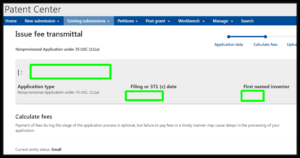In a previous blog article I reviewed USPTO’s progress with fixing known bugs in Patentcenter. In this blog article I now review USPTO’s progress in implementing feature requests and enhancements that beta users have asked USPTO to provide in Patentcenter.
By way of comparison, patent practitioners are accustomed to the responsiveness of WIPO when users suggest improvements and enhancements to the ePCT system. It is commonplace to see user-friendly features that get added to ePCT specifically because users have asked for them. WIPO personnel are subscribed to all of the relevant listservs and user groups for PCT users, and frequently it will be seen that a bug will get fixed or a feature will get added specifically because a WIPO person will have responded to a question or a comment in a listserv or in a discussion group.
If you have not already done so, you should join the PCT listserv and the Patentcenter listserv.
With this background, one might hope that USPTO would from time to time respond to suggestions and feature requests from user groups by implementing requested features or enhancements in Patentcenter. It is this hope that prompted me to carry out a review recently of the Patentcenter feature request list to see what progress USPTO has made. This blog article summarizes my findings. Continue reading “How it is going with feature requests and enhancements for Patentcenter”


